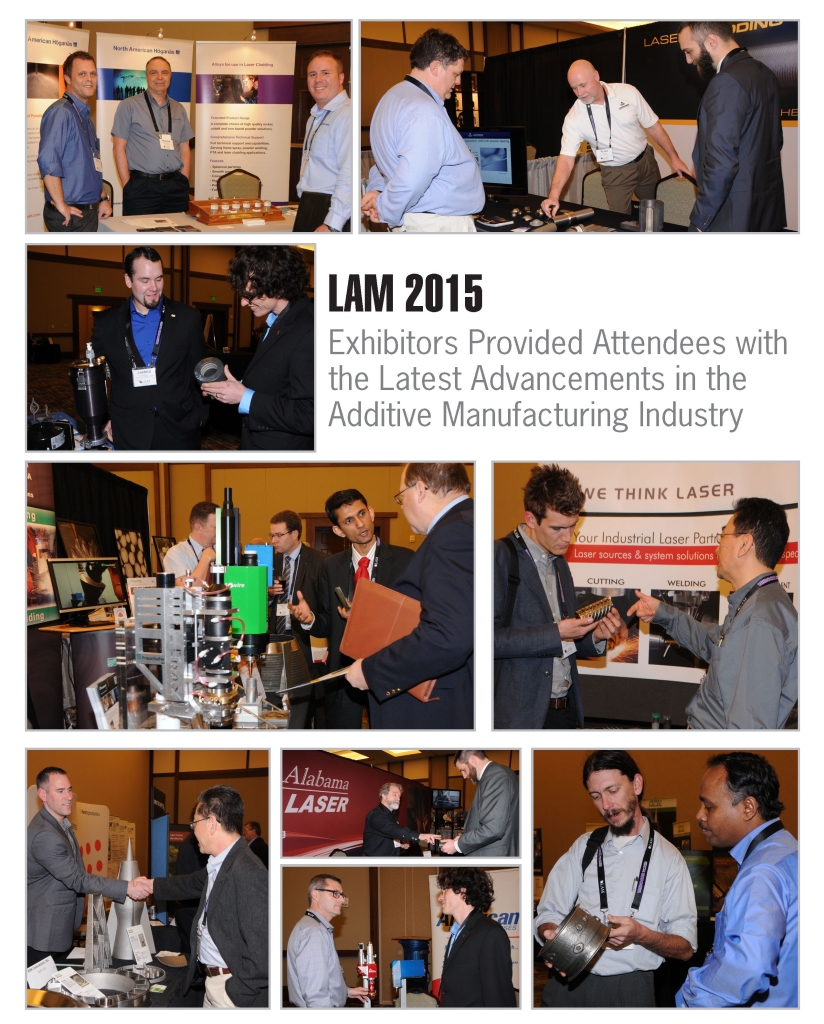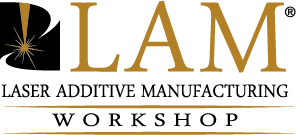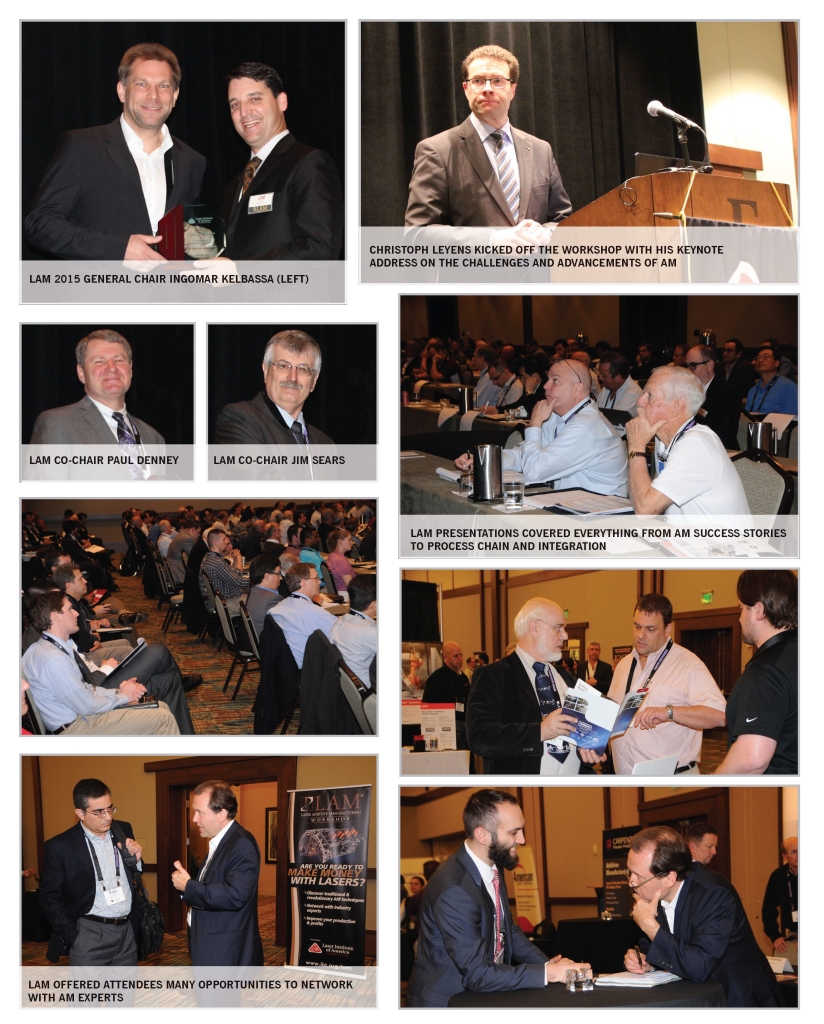By Geoff Giordano
With roughly 50 percent of the audience attending for the first time, LIA’s seventh Laser Additive Manufacturing (LAM®) Workshop fueled enthusiasm for laser-based 3D printing processes with a robust, real-world view of the state of the technology.
“We tried to address the entire process chain on the first day,” said LAM General Chair Ingomar Kelbassa, “from the raw material and design through additive manufacturing (AM) processes to adaptive finishing operations like five-axis milling. On the second day, we talked about what creates more awareness and visibility” of laser-based additive manufacturing.
Kelbassa, an adjunct professor at Australia’s RMIT University, hoped the success stories shared during LAM 2015, held Mar. 4-5 in Orlando, helped veterans and newcomers “get motivated for additive manufacturing in the future.” Attendees learned about a broad array of accomplishments and initiatives:
- Keynote speaker Christoph Leyens of Fraunhofer IWS illustrated the potential material and cost savings of layer-by-layer, near net shape manufacturing — for example, a potential reduction of up to 5,000 euros per part when producing a strongly twisted Ti64 leading edge for an aviation fan blade with AM vs. conventional machining.
- LAM co-chair Jim Sears of GE Global Research noted that 100 desktop 3D printers have been given to 1,000 members of an in-house makers guild to help engineers in GE’s aviation, corporate, health care, oil and gas, power and water, appliances and lighting divisions design parts optimized for additive production.
- BMW’s Wolfgang Thiele demonstrated how the automaker uses additive processes to produce more than 100,000 parts annually for its consumer vehicles. Furthermore, BMW has made more than 600 parts for its motor sports division, using aluminum alloy and the ReaLizer 250 machine for a complex engine component requiring undercuts.
- Tim Biermann of Fraunhofer ILT shared research into the printing of blood vessels that he suggested could lead to the additive manufacture of human tissue in about 10 years.
- Forays into higher speed multibeam additive manufacturing. Henner Schöneborn of SLM Solutions discussed the company’s Quad Laser Technology using four 400- to 700-watt fiber lasers. Max Schniedenharn of Fraunhofer ILT detailed a selective laser melting approach using a line of five diode lasers that can be switched on and off as part geometries dictate.
- James McGuffin-Cawley of Case Western Reserve University detailed the third and latest call for a project by America Makes, the National Additive Manufacturing Innovation Institute. The project is expected to begin in mid-July. Meanwhile, Richard Grylls of Optomec spotlighted the ASTM standard guide for directed energy deposition of metals. The roughly 55-page guide, in the works for two years and in the approval stage, advises readers to “be concerned about the powder, make sure you know what quality you’re supposed to be buying, make sure you have the right mesh size range,” and more, Grylls noted.
- Unique approaches to fostering AM like conformal cooling experts Linear Mold and Engineering providing long-term onsite support to customers, as well as Hayden Corp.’s creation of custom alloys.
Consensus remains that much work still needs to be done to optimize additive manufacturing — by reducing porosity, improving crack resistance, ensuring repeatable process outcomes, developing better modeling software and AM-specific powders and training a new generation of additive-oriented engineers. But LAM once again showcased how researchers, powder suppliers, laser manufacturers, job shops and national initiatives are sharing knowledge to move applications forward in various industries.
As Kelbassa noted in his introductory remarks, LAM has evolved from a conference focused on wear and corrosion protection through laser material deposition to enlighten attendees about the 3D printing revolution. Reaffirming LAM’s roots, a handful of the 24 presentations focused on the latest ways to perform bread-and-butter cladding applications.
For example, Platinum Sponsor Alabama Laser’s Wayne Penn — with 42 years in the laser industry — recommended completely machining off damaged coatings from compromised hydraulic shafts. In discussing his work on a worn ceramic-coated shaft used in a seawater environment, “It’s very important to always machine off the old coating.” Depending on the condition of the old coating, he advised you might be tempted to “just clad over it. Bad decision, (because) if you want to go after that precision bond, whatever is down in that base material is going to get washed up into that bond. It’s always best to machine (that part) down to the base material, from our experience, and then we laser hot-wire clad that and final machine it.” He was quick to note that this application can perform repairs in the field.
 New Tech, New Approaches, New Contacts
New Tech, New Approaches, New Contacts
In keeping with LAM’s evolving focus, Leyens opened the proceedings with a broad overview of the benefits and challenges of additive part production. A key way LAM helps foster “best practices” in laser-based additive manufacturing is by straight talk by industry veterans that steers clear of hype.
“It is time for the additive manufacturing community to not only look into ways we can produce parts… but also to look into materials. We need to develop materials dedicated to additive manufacturing like we have developed materials dedicated to forging or casting. If we do this right, we will end up with the microstructures we need.”
Added Sears, AM in general “is a technology that provides solutions.” After 20 years of discussing the possibilities, he said, it is imperative to move additive processes out of labs and “harden” systems for manufacturing to make sure “the first part we make is the same as the thousandth.” To that end he stressed the need for more additive-friendly design software, more scanners and better inspection methods to ensure internal features are sound. System makers are adapting to keep lasers building closer to 95 percent of the time.
At Siemens, AM will help produce multiple parts throughout future gas turbines to make them more efficient and durable, said Allister James.
Meanwhile, Penn detailed a cladding procedure for water wall panels, which are made up of multiple boiler tubes welded together and ranging from 10 to 40 ft long and up to 5 ft wide. Instead of moving the part to clad these undulating 3D surfaces with a fixed beam, Alabama Laser developed a flying-optic system for which a patent is pending.
After the last presentation, most people remaining in the audience indicated they had learned something at LAM 2015. At breaks between sessions, as well as during a vendor reception, attendees crowded an exhibition hall packed with key AM players.
“I came for some of the connections I wanted to make,” said Todd Rockstroh of GE Aviation, who has presented at several LIA events. “You can grab (experts) and pull them to the side and find out what’s really going on. We’re all looking for bigger machines.”
For Leyens, who estimated this was his fourth LAM, “it’s always great to be here to meet old friends (and) to make new friends.” For powder producer Ametek, exhibiting for the second year, New Business Development Manager Cindy Freeby noted that moving LAM from Houston to Orlando was “a good thing, because you get some different people.”
LAM returns to Orlando Mar. 2-3, 2016, when past general chair Paul Denney of Lincoln Electric returns to the helm. Visit www.lia.org/lam for updates.







